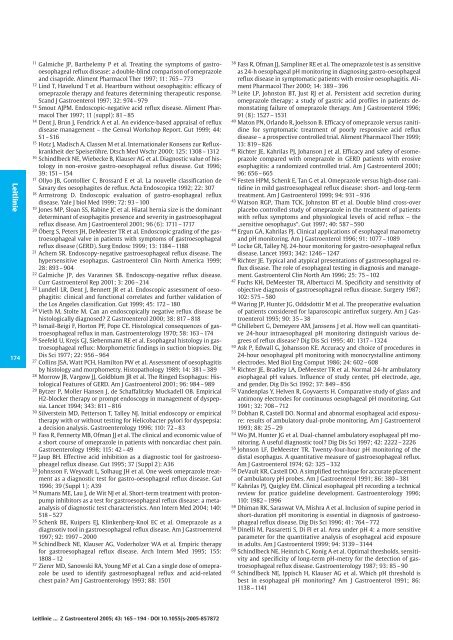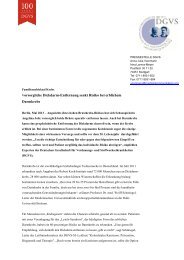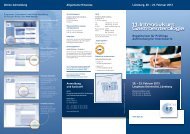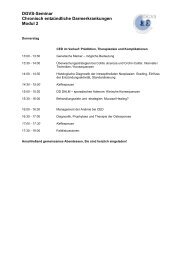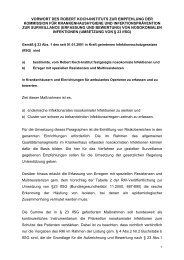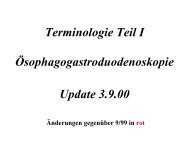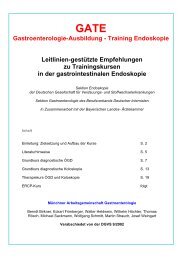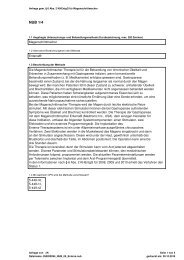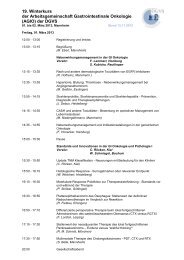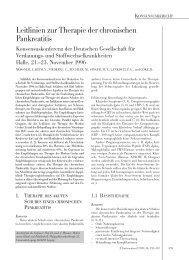Gastroösophageale Refluxkrankheit – Ergebnisse einer - DGVS
Gastroösophageale Refluxkrankheit – Ergebnisse einer - DGVS
Gastroösophageale Refluxkrankheit – Ergebnisse einer - DGVS
Sie wollen auch ein ePaper? Erhöhen Sie die Reichweite Ihrer Titel.
YUMPU macht aus Druck-PDFs automatisch weboptimierte ePaper, die Google liebt.
Leitlinie 174<br />
11 Galmiche JP, Barthelemy P et al. Treating the symptoms of gastrooesophageal<br />
reflux disease: a double-blind comparison of omeprazole<br />
and cisapride. Aliment Pharmacol Ther 1997; 11: 765 <strong>–</strong> 773<br />
12 Lind T, Havelund T et al. Heartburn without oesophagitis: efficacy of<br />
omeprazole therapy and features determining therapeutic response.<br />
Scand J Gastroenterol 1997; 32: 974 <strong>–</strong>979<br />
13 Smout AJPM. Endoscopic-negative acid reflux disease. Aliment Pharmacol<br />
Ther 1997; 11 (suppl): 81 <strong>–</strong>85<br />
14 Dent J, Brun J, Fendrick A et al. An evidence-based appraisal of reflux<br />
disease management <strong>–</strong> the Genval Workshop Report. Gut 1999; 44:<br />
S1<strong>–</strong>S16<br />
15 Hotz J, Madisch A, Classen M et al. Internationaler Konsens zur <strong>Refluxkrankheit</strong><br />
der Speiseröhre. Dtsch Med Wschr 2000; 125: 1308 <strong>–</strong> 1312<br />
16 Schindlbeck NE, Wiebecke B, Klauser AG et al. Diagnostic value of histology<br />
in non-erosive gastro-oesophageal reflux disease. Gut 1996;<br />
39: 151 <strong>–</strong>154<br />
17 Ollyo JB, Gontollier C, Brossard E et al. La nouvelle classification de<br />
Savary des oesophagites de reflux. Acta Endoscopica 1992; 22: 307<br />
18 Armstrong D. Endoscopic evaluation of gastro-esophageal reflux<br />
disease. Yale J biol Med 1999; 72: 93 <strong>–</strong>100<br />
19 Jones MP, Sloan SS, Rabine JC et al. Hiatal hernia size is the dominant<br />
determinant of esophagitis presence and severity in gastroesophageal<br />
reflux disease. Am J Gastroenterol 2001; 96 (6): 1711 <strong>–</strong> 1717<br />
20 Öberg S, Peters JH, DeMeester TR et al. Endoscopic grading of the gastroesophageal<br />
valve in patients with symptoms of gastroesophageal<br />
reflux disease (GERD). Surg Endosc 1999; 13: 1184 <strong>–</strong> 1188<br />
21 Achem SR. Endoscopy-negative gastroesophageal reflux disease. The<br />
hypersensitive esophagus. Gastroenterol Clin North America 1999;<br />
28: 893<strong>–</strong>904<br />
22 Galmiche JP, des Varannes SB. Endoscopy-negative reflux disease.<br />
Curr Gastroenterol Rep 2001; 3: 206 <strong>–</strong> 214<br />
23 Lundell LR, Dent J, Bennett JR et al. Endoscopic assessment of oesophagitis:<br />
clinical and functional correlates and further validation of<br />
the Los Angeles classification. Gut 1999; 45: 172 <strong>–</strong> 180<br />
24 Vieth M, Stolte M. Can an endoscopically negative reflux disease be<br />
histologically diagnosed? Z Gastroenterol 2000; 38: 817 <strong>–</strong> 818<br />
25 Ismail-Beigi F, Horton PF, Pope CE. Histological consequences of gastroesophageal<br />
reflux in man. Gastroenterology 1970; 58: 163 <strong>–</strong> 174<br />
26 Seefeld U, Krejs GJ, Siebenmann RE et al. Esophageal histology in gastroesophageal<br />
reflux: Morphometric findings in suction biopsies. Dig<br />
Dis Sci 1977; 22: 956 <strong>–</strong> 964<br />
27 Collins JSA, Watt PCH, Hamilton PW et al. Assessment of oesophagitis<br />
by histology and morphometry. Histopathology 1989; 14: 381 <strong>–</strong> 389<br />
28 Morrow JB, Vargow JJ, Goldblum JR et al. The Ringed Esophagus: Histological<br />
Features of GERD. Am J Gastroenterol 2001; 96: 984 <strong>–</strong> 989<br />
29 Bytzer P, Moller Hansen J, de Schaffalitzky Muckadell OB. Empirical<br />
H2-blocker therapy or prompt endoscopy in management of dyspepsia.<br />
Lancet 1994; 343: 811 <strong>–</strong> 816<br />
30 Silverstein MD, Petterson T, Talley NJ. Initial endoscopy or empirical<br />
therapy with or without testing for Helicobacter pylori for dyspepsia:<br />
a decision analysis. Gastroenterology 1996; 110: 72<strong>–</strong> 83<br />
31 Fass R, Fennerty MB, Ofman JJ et al. The clinical and economic value of<br />
a short course of omeprazole in patients with noncardiac chest pain.<br />
Gastroenterology 1998; 115: 42 <strong>–</strong> 49<br />
32 Jaup BH. Effective acid inhibition as a diagnostic tool for gastroesopheagel<br />
reflux disease. Gut 1995; 37 (Suppl 2): A36<br />
33 Johnsson F, Weyvadt L, Solhaug JH et al. One week omeprazole treatment<br />
as a diagnostic test for gastro-oesophageal reflux disease. Gut<br />
1996; 39 (Suppl 1): A39<br />
34 Numans ME, Lau J, de Wit NJ et al. Short-term treatment with protonpump<br />
inhibitors as a test for gastroesophageal reflux disease: a metaanalysis<br />
of diagnostic test characteristics. Ann Intern Med 2004; 140:<br />
518 <strong>–</strong> 527<br />
35 Schenk BE, Kuipers EJ, Klinkenberg-Knol EC et al. Omeprazole as a<br />
diagnsotiv tool in gastroesophageal reflux disease. Am J Gastroenterol<br />
1997; 92: 1997<strong>–</strong> 2000<br />
36 Schindlbeck NE, Klauser AG, Voderholzer WA et al. Empiric therapy<br />
for gastroesophageal reflux disease. Arch Intern Med 1995; 155:<br />
1808 <strong>–</strong> 12<br />
37 Zierer MD, Sanowski RA, Young MF et al. Can a single dose of omeprazole<br />
be used to identify gastroesophageal reflux and acid-related<br />
chest pain? Am J Gastroenterology 1993; 88: 1501<br />
Leitlinie … Z Gastroenterol 2005; 43: 165 <strong>–</strong> 194 · DOI 10.1055/s-2005-857872<br />
38 Fass R, Ofman JJ, Sampliner RE et al. The omeprazole test is as sensitive<br />
as 24-h oesophageal pH monitoring in diagnosing gastro-oesophageal<br />
reflux disease in symptomatic patients with erosive oesophagitis. Aliment<br />
Pharmacol Ther 2000; 14: 389<strong>–</strong>396<br />
39 Leite LP, Johnston BT, Just RJ et al. Persistent acid secretion during<br />
omeprazole therapy: a study of gastric acid profiles in patients demonstating<br />
failure of omeprazole therapy. Am J Gastroenterol 1996;<br />
91 (8): 1527 <strong>–</strong> 1531<br />
40 Maton PN, Orlando R, Joelsson B. Efficacy of omeprazole versus ranitidine<br />
for symptomatic treatment of poorly responsive acid reflux<br />
disease <strong>–</strong> a prospective controlled trial. Aliment Pharmacol Ther 1999;<br />
13: 819 <strong>–</strong> 826<br />
41 Richter JE, Kahrilas PJ, Johanson J et al. Efficacy and safety of esomeprazole<br />
compared with omeprazole in GERD patients with erosive<br />
esophagitis: a randomized controlled trial. Am J Gastroenterol 2001;<br />
96: 656 <strong>–</strong> 665<br />
42 Festen HPM, Schenk E, Tan G et al. Omeprazole versus high-dose ranitidine<br />
in mild gastroesophageal reflux disease: short- and long-term<br />
treatment. Am J Gastroenterol 1999; 94: 931 <strong>–</strong> 936<br />
43 Watson RGP, Tham TCK, Johnston BT et al. Double blind cross-over<br />
placebo controlled study of omeprazole in the treatment of patients<br />
with reflux symptoms and physiological levels of acid reflux <strong>–</strong> the<br />
„sensitive oesophagus“. Gut 1997; 40: 587 <strong>–</strong> 590<br />
44 Ergun GA, Kahrilas PJ. Clinical applications of esophageal manometry<br />
and pH monitoring. Am J Gastroenterol 1996; 91: 1077 <strong>–</strong> 1089<br />
45 Locke GR, Talley NJ. 24-hour monitoring for gastro-oesophageal reflux<br />
disease. Lancet 1993; 342: 1246<strong>–</strong> 1247<br />
46 Richter JE. Typical and atypical presentations of gastroesophageal reflux<br />
disease. The role of esophageal testing in diagnosis and management.<br />
Gastroenterol Clin North Am 1996; 25: 75 <strong>–</strong> 102<br />
47 Fuchs KH, DeMeester TR, Albertucci M. Specificity and sensitivity of<br />
objective diagnosis of gastroesophageal reflux disease. Surgery 1987;<br />
102: 575 <strong>–</strong> 580<br />
48 Waring JP, Hunter JG, Oddsdottir M et al. The preoperative evaluation<br />
of patients considered for laparoscopic antireflux surgery. Am J Gastroenterol<br />
1995; 90: 35<strong>–</strong>38<br />
49 Ghillebert G, Demeyere AM, Janssens J et al. How well can quantitative<br />
24-hour intraesophageal pH monitoring distinguish various degrees<br />
of reflux disease? Dig Dis Sci 1995; 40: 1317 <strong>–</strong>1324<br />
50 Ask P, Edwall G, Johansson KE. Accuracy and choice of procedures in<br />
24-hour oesophageal pH monitoring with monocrystalline antimony<br />
electrodes. Med Biol Eng Comput 1986; 24: 602 <strong>–</strong> 608<br />
51 Richter JE, Bradley LA, DeMeester TR et al. Normal 24-hr ambulatory<br />
esophageal pH values. Influence of study center, pH electrode, age,<br />
and gender. Dig Dis Sci 1992; 37: 849 <strong>–</strong> 856<br />
52 Vandenplas Y, Helven R, Goyvaerts H. Comparative study of glass and<br />
antimony electrodes for continuous oesophageal pH monitoring. Gut<br />
1991; 32: 708<strong>–</strong>712<br />
53 Dobhan R, Castell DO. Normal and abnormal esophageal acid exposure:<br />
results of ambulatory dual-probe monitoring. Am J Gastroenterol<br />
1993; 88: 25 <strong>–</strong>29<br />
54 Wo JM, Hunter JG et al. Dual-channel ambulatory esophageal pH monitoring.<br />
A useful diagnostic tool? Dig Dis Sci 1997; 42: 2222 <strong>–</strong> 2226<br />
55 Johnson LF, DeMeester TR. Twenty-four-hour pH monitoring of the<br />
distal esophagus. A quantitative measure of gastroesophageal reflux.<br />
Am J Gastroenterol 1974; 62: 325 <strong>–</strong> 332<br />
56 DeVault KR, Castell DO. A simplified technique for accurate placement<br />
of ambulatory pH probes. Am J Gastroenterol 1991; 86: 380 <strong>–</strong> 381<br />
57 Kahrilas PJ, Quigley EM. Clinical esophageal pH recording a technical<br />
review for pratice guideline development. Gastroenterology 1996;<br />
110: 1982 <strong>–</strong> 1996<br />
58 Dhiman RK, Saraswat VA, Mishra A et al. Inclusion of supine period in<br />
short-duration pH monitoring is essential in diagnosis of gastroesophageal<br />
reflux disease. Dig Dis Sci 1996; 41: 764 <strong>–</strong> 772<br />
59 Dinelli M, Passaretti S, Di FI et al. Area under pH 4: a more sensitive<br />
parameter for the quantitative analysis of esophageal acid exposure<br />
in adults. Am J Gastroenterol 1999; 94: 3139 <strong>–</strong>3144<br />
60 Schindlbeck NE, Heinrich C, Konig A et al. Optimal thresholds, sensitivity<br />
and specificity of long-term pH-metry for the detection of gastroesophageal<br />
reflux disease. Gastroenterology 1987; 93: 85 <strong>–</strong> 90<br />
61 Schindlbeck NE, Ippisch H, Klauser AG et al. Which pH threshold is<br />
best in esophageal pH monitoring? Am J Gastroenterol 1991; 86:<br />
1138 <strong>–</strong> 1141


